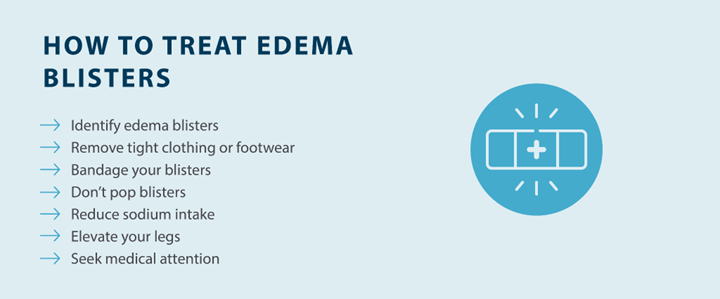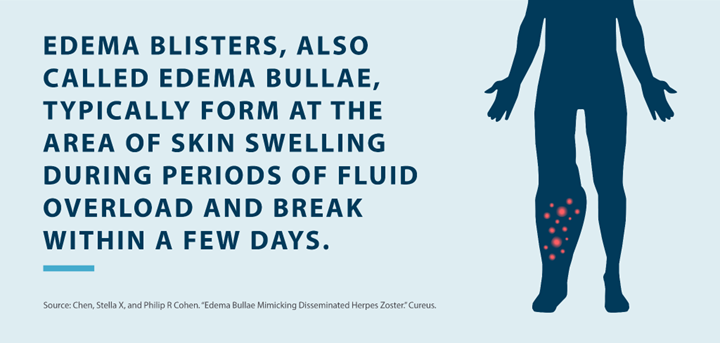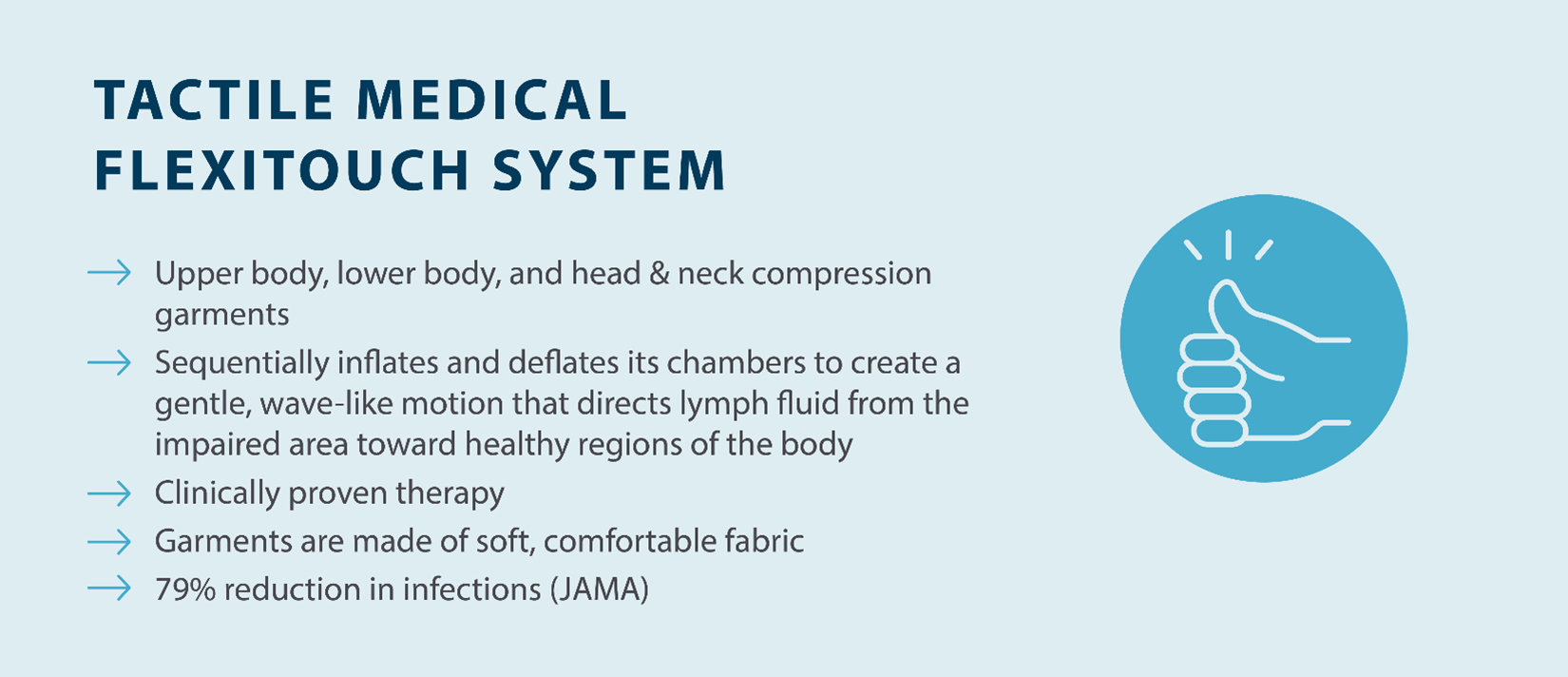How to Treat Edema Blisters


Edema blisters can be painful and make simple aspects of life more difficult. These blisters are caused by a buildup of fluid underneath the skin, which can eventually lead to the skin in the blistered area to break and release that fluid. While this is more common in the elderly and people who are less mobile, edema blisters can occur in any patient with swelling.
If you’re experiencing blisters as a result of your edema, there are several treatment options that can help. Edema blister treatment starts with identifying any blisters you may have. Before you take steps toward treatment, you should talk to your doctor first. Below is a guide to treating edema blisters to help you learn about your options.
What Are Edema Blisters?
How Do You Treat Edema Blisters?
How to Prevent Edema Blisters
Key Takeaways: Treating Edema Blisters
What Are Edema Blisters?
Edema blisters, also called edema bullae, are blisters that occur as a result of edema, which is a buildup of fluid in your body’s tissues. These blisters contain sterile fluid that is often released within a few days after the blister is formed. Edema blisters are more common in elderly and immobile patients, but they may also occur during renal or cardiac failure in patients with edema.

Edema blisters may form as a result of fluid leaving the small blood vessels (called capillaries) at a rate that is too fast for the lymphatic system to drain. Normally, this capillary fluid moving from the blood vessels into our tissues is at a rate that allows for the lymphatics to keep up. However, when there’s too much fluid being pushed into the lymphatic system, the lymphatic system can’t drain, which can lead to blistering.
Edema blisters have a thin roof, which makes them susceptible to breaking, which can increase the risk of infection. It is best to find ways to treat any edema or this imbalance of fluid to help prevent blisters from forming in the future. Finding ways to resolve the imbalance of fluid can help prevent blisters from forming in the future. In the sections below, you’ll find the steps you can take to treat edema blisters.
How Do You Treat Edema Blisters?
Edema blisters can cause pain and even lead to infection, which is why it’s important to know how to treat them. Treatment is generally focused on protecting the area where blisters form and finding ways to decrease swelling as a result of edema. If you want to know more about treating edema blisters, here’s a detailed breakdown:

1. Identify edema blisters
The first step to treating edema blisters is identifying any blisters you may have. This is an essential first step because part of treating blisters is covering them up with bandages to protect them. You may notice a blister on your foot, hand, arm, or leg. If that blister is filled with blood or another colored fluid, it most likely isn’t related to edema. Edema blisters are generally filled with clear fluid and have a thin roof, so look for blisters that appear to be clear rather than filled with blood or pus.
2. Remove tight clothing or footwear
Comfortable clothing and footwear are also recommended for treating edema blisters. Tight clothes and shoes can promote edema, especially in your legs, feet, and ankles. Tight clothing and footwear can irritate your blisters. Switching to looser clothes can help remedy that problem, and you may find that looser clothes are more comfortable if you’re living with edema. It’s also important to find a comfortable pair of shoes if you have blisters and swelling on your feet.
3. Bandage your blisters
Protecting your blisters is an important part of edema blister treatment, so make sure you bandage up any blisters you identify. You should choose a bandage that’s large enough to cover the entire blister to ensure the bandage’s adhesive isn’t touching the blister itself. If the bandage is rubbing up against the blister, it could irritate it or cause it to break, which can lead to infection if left untreated.
4. Don’t pop blisters
It’s important to note that you should avoid popping blisters at all costs. As tempting as it may be to pop an edema blister and relieve the pressure of that built-up fluid, popping blisters increases your risk of infection. If you accidentally pop a blister, you should wash the area with soapy water and put petroleum jelly over it for protection. In some cases, your doctor may be able to drain your edema blisters for you.
5. Reduce sodium intake
A preventative measure you can take to lower your chance of forming edema blisters is reducing your sodium intake. A diet high in sodium can result in increased fluid retention that makes edema worse. If your current diet consists of processed and packaged foods, an alternative can be cooking at home, as you’re able to monitor how much salt is in your meals. Even canned fruits and vegetables can have high sodium contents, so it’s best to eat fresh. You can also cook with low-sodium seasonings to give your food more flavor without the added salt. Always consult with your doctor if you have questions about changes to your diet.
6. Elevate your legs
Edema is caused by a buildup of fluid in your body’s tissues, which means you can get relief from edema by elevating the part of your body where fluid is accumulating. Since edema is most common in the lower body, elevating your legs can be a great way to reduce swelling. In fact, leg elevation is a crucial aspect of how to treat edema blisters on legs. When you elevate your legs, make sure you have cushioning underneath to avoid putting too much pressure directly on your blisters.
7. Seek medical attention
While there are plenty of ways to get relief from edema blisters at home, it’s important to understand that you can’t always treat edema blisters on your own. If your edema blisters are progressing or won’t heal after a few days, it’s recommended to schedule an appointment with your doctor. Your doctor can accurately judge the severity of your edema and help you find the right treatment options to find relief.
How to Prevent Edema Blisters
Edema blisters can be painful. Fortunately, there are steps you can take to prevent them. By determining the underlying cause of your edema and talking to a doctor about treatment and prevention options, you can avoid blisters and get relief from edema.
Determining the cause of your edema is the first step. Edema can be caused by various factors, from heart failure and kidney disease to disruptions of the lymphatic system and allergic reactions. Your doctor can help you identify the cause of your edema by taking a look at your diet, your lifestyle choices, and your overall health. Once you know the root cause of your edema, you can work on treating that underlying cause to get relief.
If your edema is caused by dietary or lifestyle issues, your doctor can provide advice on maintaining a healthier lifestyle. If it’s caused by heart disease or kidney failure, they may recommend more advanced treatment options that are designed to treat these health conditions.
You should also ask your doctor about compression garments to help relieve pain and reduce swelling. Compression garments help encourage the movement of fluid throughout your body to prevent it from pooling up in one place. These garments can be a very effective tool in preventing edema blisters, but it’s important to talk to your doctor first to figure out whether or not compression garments are right for you.
At Tactile Medical, we have a wide range of lymphedema treatment and management options that can help manage symptoms associated with edema, lymphedema, and lipedema. The Flexitouch Plus system provides upper body edema treatment, head and neck treatment, and lower body edema treatment.

The Flexitouch Plus system is designed to stimulate your lymphatic system to encourage lymphatic drainage to reduce swelling and pain at home, which can also help reduce the likelihood of blisters. Again, it’s important to talk to your doctor to determine whether the Flexitouch Plus is right for you. Your doctor can help you come up with a treatment plan that relieves edema symptoms and prevents edema blisters.
Key Takeaways: Treating Edema Blisters
Edema blisters are a somewhat common occurrence for people living with edema. Fortunately, edema blisters are preventable, and treating your blisters is a fairly simple process. The most important step in treating edema blisters is identifying them early on to protect them from bursting and getting infected.
Treating your edema is also another way to treat your blisters. At Tactile Medical, our lymphedema treatment systems for the head, neck, arms, and legs can be used to reduce swelling and pain associated with edema. Our doctor-recommended pneumatic compression devices can be used at home, so you can manage your symptoms on your own. If you’re experiencing any edema, lymphedema, or lipedema symptoms, get in touch with Tactile Medical today.